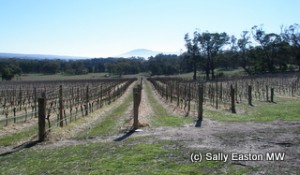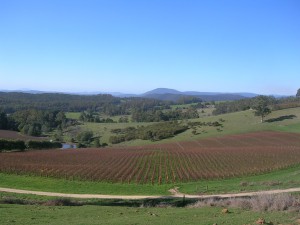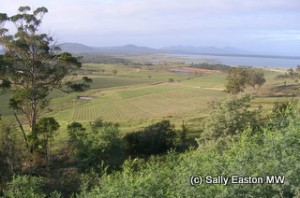Cool climate Australia
A version of this article first appeared in The Drinks Business, January 2008.
What makes cool climate Australia so trendy all of a sudden? If you believe much of the marketing blurb it seems that any region other than the Murray Valley is suddenly ‘cool climate’. It’s time to and pin down cool climate to some identifiable locations, whose wines attributes that differentiate them from wines from warmer areas.
The temperature map of Australia in the new edition of the World Atlas of Wine shows only a few spots of potentially cool climate, and they are south of the Great Dividing Range, where January (July in the northern hemisphere) surface temperature is below 20°C. The theory goes that cooling Southern Ocean winds creep into part of the south-facing slopes of the mountains, helping moderate temperature. As soon as you’re over the top of the mountains, things warm up considerably – you’re on your way to the interior.

Macedon Ranges
This is perfectly exemplified by the Macedon Ranges/Heathcote boundary in Victoria. The Macedon Ranges, about an hour northwest of Melbourne, are acknowledged as the mainland’s coolest wine-growing region. It sits atop the south facing slopes of the Great Dividing Range. It is gaining reputation for its sparkling-wine fruit, chardonnay, and cool climate talisman pinot noir. Acclaimed Michael Dhillon, of Bindi, makes his wine in the Macedon Ranges, as does Phillip Moraghan at Curly Flat. Moraghan spent 18 months searching cool-er climate Australia before settling in the Macedon Ranges, having become empassioned about ‘pinot grief’ as he says, in Switzerland.
Immediately north of Macedon is reputed shiraz-territory, Heathcote, which is already atop the north-facing slopes of the Great Dividing Range, and considerably warmer.
Temperature is generally acknowledged as being the primary determinant of climatic suitability for viticulture. See below for the nitty-gritty. But cool defining climate is much trickier as so may other parameters come into play: exposition, proximity to bodies of water, wind (speed, direction, temperature, humidity, timing), evapotranspiration, cloud cover, annual rainfall patterns, ripening-season rainfall, altitude. Vintage variation is a given.
Why is it important?
Cool climate has become shorthand for high quality. There’s an anecdotal association with longevity in bottle. Though, if Bordeaux is deemed cool climate, it’s only too well known there’s poor quality there, but there’s also the best.

North Tasmania
Scale is factor. No cool climate region is large and homogenous. As Chris Smith, viticultural manager at Tasmania’s Cloverhill, said: “when in a cool climate, vineyard practices have to be very precise”.
Claudio Radenti, of Freycinet Vineyard in Tasmania, said: “go a few kilometres and things change. For us site selection is very important, shelter from the westerly winds” and for pinot noir keeping the yield down to grand cru levels. Though yield and attention to detail are commercial considerations, benefits include individuality of expression, complexity, finesse, and a higher return per bottle through a necessarily higher price.
Even the new Aussie industry strategy, Directions 2025, pays attention to the status of wines of place. Having ruled the roost for a decade and more with inter-regional blends, the industry wants to exploit the points of difference offered by cooler climate: different flavour profiles, higher price points, a focus on cool-fruit sparkling wines, grape varieties more expressive of the terroir, though heaven forfend the Aussies would use such a word.
Cool climate from the wine up
A warmer climate seems pretty easy to identify: lower acidity, higher alcohol, fuller body, sweeter, jammier fruit, overt alcohol, high extract easily achieved.
Too cold is pretty easy too: the grapes don’t ripen. Which makes cool climate ‘just warm enough’ to ripen fruit before the cold of autumn sets in.
Pirie Tasmania‘s Dr Andrew Pirie, a cool climate specialist, postulates true cool climate as “regions with a mean January [or July] temperature equal or less than 19.0°C or 1150 day degrees (see below). It corresponds with the ability to ripen pinot noir, pinot gris, traminer, chardonnay and sauvignon blanc, but not semillon, merlot or cabernet franc except in exceptional locations.” This would include Tasmania, Macedon, parts of Mornington and parts of the Yarra Valley.
Tasmania is undoubtedly Australia’s coolest climate, and it is reclaiming its main defining characteristic under the banner ‘true cool climate wines’. A look at Tassie’s key grape varieties – chardonnay, riesling, gewürztraminer, pinot gris, sauvignon blanc, and pinot noir – pretty much confirm Pirie’s thesis. Sparkling wines are a forte.

East Coast Tasmania
Francine Austin, winemaker at Hardy’s Tasmanian Bay of Fires winery is very clear: “cool climate is a combination of two things: finesse and elegance. A tightness of wine combined with power from a high concentration of aromatic flavour compounds.” For this, she said “high sunshine hours and lower temperatures are needed which retain delicate aromatic compounds. Acid degradation is slow, and ripening season day time temperature does not exceed 25°C.”
The science stuff
Drs. Amerine and Winkler (1944) defined five regions of California using a temperature index. Using a seven month growing season, they calculated the ‘degree days’ above 10°C (at which temperature vines generally start growing). Mean monthly temperature less 10 (degrees) multiplied by the number of days in the month, and totalled for the seven months.
They came up with five regions, which still form the bedrock of viticultural climatic data. Their system has been variously refined, amended and critiqued, but not abandoned.
Region I is the coolest. Each region can be matched to the mean temperature of the warmest month (MJT) – January or July. From the regions that fit into the model, typical grape varieties can be identified.
| Region | degree days | MJT °C | grape varieties | wine regions |
| Region I | <1390 | <19.8 | pinot noir, riesling, chardonnay, gewurztraminer, pinot grigio sauvignon blanc | Chablis, Friuli, Tasmania, Champagne, Marlborough |
| Region II | 1391 to 1670 | 19.9 to 21.3 | cabernet sauvignon, chardonnay, merlot, semillon, syrah | Bordeaux, Alsace, Yarra Valley, Frankland River |
| Region III | 1671 to 1940 | 21.4 to 22.8 | grenache, barbera, tempranillo, syrah, | Clare Valley, Lower Hunter, Rioja, Piemonte |
| Region IV | 1941 to 2220 | 22.9 to 24.3 | carignan, cinsault, mourvedre, tempranillo | McLaren Vale, Upper Hunter, Langhorne Creek, Montpellier |
| Region V | >2220 | >24.3 | primitivo, nero d’avola, palomino, fiano | Greek Islands, Jerez, Sicily, Sardinia |
Source: paper by Dr. Andrew Pirie – ‘Defining Cool Climate’. Stratford’s Brave New World seminar, London, September 2007
Dr. John Gladstones developed the model for Australia. Drs. Peter Dry and Richard Smart developed a homoclime approach, using a range of climatic measures including radiation, rainfall and relative humidity. Pirie brought in growing-season rainfall and humidity to the blooming algebraic calculation, to account for low vine-moisture stress during growing time.
Selection of locations to show MJT and degree days
|
|
MJT °C | Degree Days |
| Tasmania. south |
16.8 |
1013 |
| Tasmania, north |
17.2 |
1020 |
| Macedon Ranges |
17.2 to 18.5 |
970 to 1050 |
| Mornington Peninsula |
18.8 to 20 |
1080 to 1570 |
| Yarra Valley |
17.9 to 19.4 |
1250 to 1352 |
| Frankland |
19 |
1441 |
| Geelong |
19 |
1470 |
| Adelaide Hills |
19.1 |
1270 |
| Coonawarra |
19.6 |
1430 |
| Margaret River |
20.4 |
1690 |
| Barossa Valley |
21.4 |
1710 |
| Lower Hunter |
22.7 |
2070 |
|
|
|
|
| Marlborough, NZ |
17.7 |
1101 |
| Rheingau |
18.6 |
1042 |
| Champagne |
18.9 |
1031 |
| Burgundy, France |
19.7 |
1164 |
| Bordeaux |
20.3 |
1392 |
| Napa Valley |
21.7 |
1499 |
| Northern Rhône |
22.5 |
1334 |
| Tuscany |
24.2 |
1477 |
Sources:
Wine Atlas of the World, sixth edition. eds. Hugh Johnson, Jancis Robinson
Wine Atlas of Australia. James Halliday
Viticulture and Environment. John Gladstones
NB: values from different sources may not be directly comparable.



